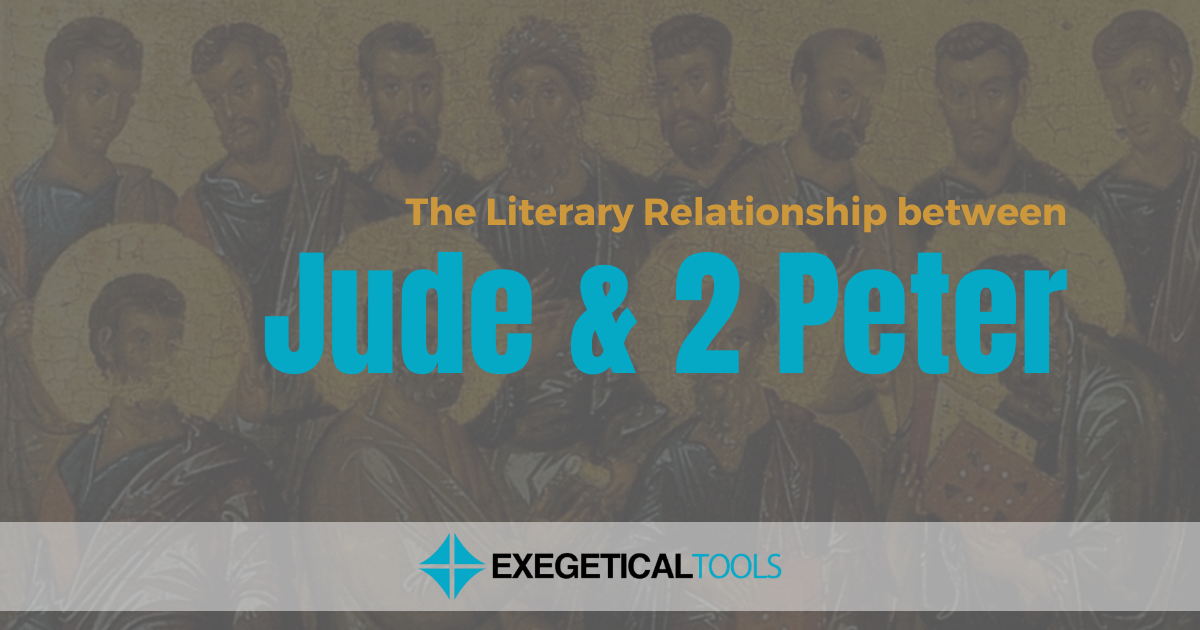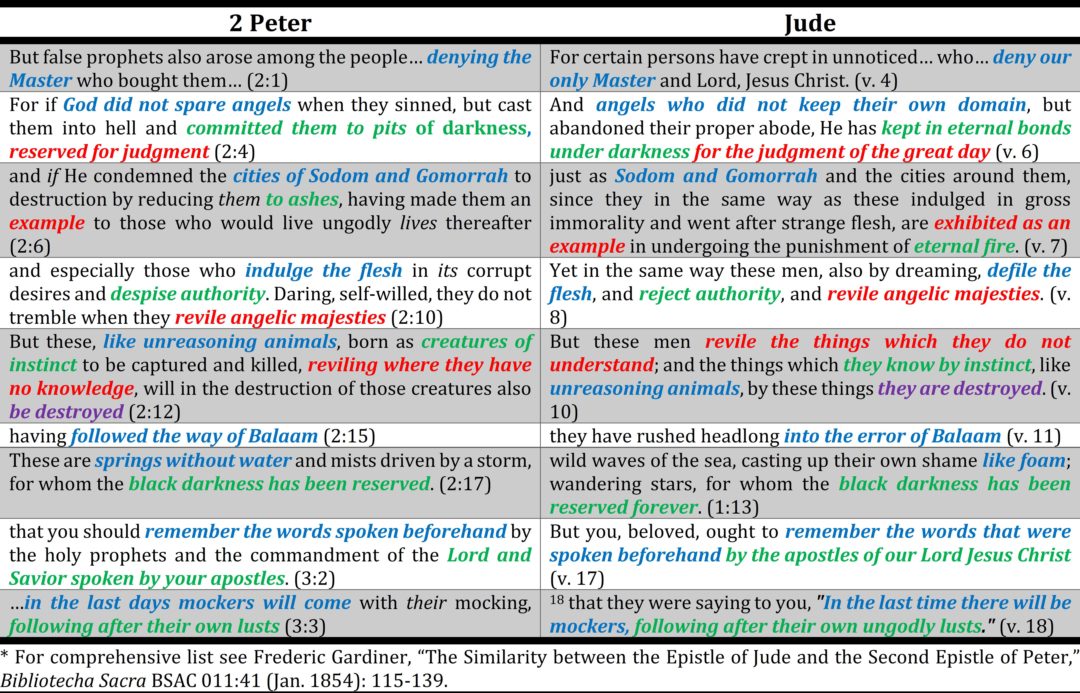
When reading through 2 Peter and Jude, striking similarities between these two letters may alert even the casual reader. An obvious resemblance becomes evident when one compares Jude 4-18, 24-25 with 2 Peter 2:1—3:3, 14, 18. The following chart shows some examples of the similarities found in both passages:

Scholars from Martin Luther to the present have not come up with a consensus to explain these similarities. This short article surveys five major explanations regarding the literary relationship between 2 Peter and Jude.
View 1: Independent Writing
One view argues that an explanation is unnecessary since both writers wrote independently from each other. This view is motivated by the desire to defend the doctrine of inspiration. Gaebelein, for example, argues that,
“If Peter sat down and copied Jude, what Peter wrote was not inspired, but copied. And if Jude sat down and wrote after the pattern of Peter, copied him, and worked over his testimony, then Jude is not inspired. But both, Peter and Jude were inspired, and therefore wrote independent of each other, the Holy Spirit guiding their respective pens, in giving the same testimony of warning” (Gaebelein, 9:96-97).
The problem with this view is that copying from another source is not necessarily problem for inspiration. Luke, for example, mentioned that his historical report was copied from various sources (cf. Luke 1:3). It is also common among the New Testament writers to quote from other inspired writers in their own letters.
View 2: Single Writer
The second proposed explanation is that both epistles were written by Jude. While the previous view defends the doctrine of inspiration, this view doubts the Petrine authorship of 2 Peter. John Robinson speculates that Jude wrote both his epistle and 2 Peter. He puts it mildly,
“Jude is representing Peter rather than impersonating him. But he leaves his own signature. For he calls him what he called him—Simeon [instead of Simon]….The only other person who is recorded as retaining this Hebraic use is his [Jude’s] brother James (Acts 15:14): it was in the family” (Robinson, 194).
View 3: Third Source
The third view claims that both Peter and Jude copied from an unknown third source. Having an unknown source is not uncommon in NT scholarship. Many scholars have attempted to explain the synoptic problem by claiming that the gospel writers were dependent on an unknown source called “Q.” And as mentioned before, Luke admits to using sources to compose his Gospel, so this view is not problematic for inspiration.
Bo Reicke argues for the possibility of both Peter and Jude employing an oral sermon pattern common during the first century (Reicke, 189-190). Schreiner, however, argues that the unusual themes found in both epistles such as the reference to fallen angels were not found in common sermons during the first century (Schreiner, 418).
View 4: Priority of Jude
The argument that Peter was dependent on Jude is the consensus of the majority of modern Bible scholars. The most common argument for this view is the brevity of Jude. The shorter epistle is most likely to be written first. Why would there be a need for Jude if 2 Peter were already written? Peter naturally elaborated on Jude’s material.
Another argument is the absence of non-canonical quotations in 2 Peter. Some contend that 2 Peter was written at a later date when the church had a stronger “canon consciousness,” which explains Peter’s omission of the 1 Enoch quotation (cf. Carson and Moo, 656-657). It is also observed that Jude’s language is harsher than Peter’s. The conclusion was that Peter toned down Jude’s stronger tenor (Guthrie, 241). In addition, Hagner observes that the Old Testament examples were chronologically arranged in 2 Pet. 2:4-8, but not in Jude 5-7. He then concludes that Peter must have reordered and supplemented Jude’s Old Testament references (Hagner, 706).
View 5: Priority of 2 Peter
The priority of 2 Peter has historically been the position of the church fathers, grounded on Peter’s apostleship. Hiebert observes that
“the studied arrangement of the material into triplets, which prevails in Jude, looks more like a second writer working up old material than a writer who was not under the influence of a predecessor” (Hiebert, 198).
The argument is that the rougher writing style of Peter was smoothed out by Jude. Advocates of this view argue that the shorter epistle is not necessarily the older, and neither letter was written late enough to be in the era of “canon consciousness” (Carson and Moo, 656-657). Another argument is that Jude had been quoting from various sources in his epistle, and therefore it is not surprising for him to quote from 2 Peter. It has also been suggested that Jude probably had read 2 Peter, resulting in the sudden change in what he was going to write about (Jude 3). Another explanation could be that Jude wrote hurriedly and drew on whatever suitable material was available (Green, 51).
The arguments so far for both the priority of Jude and the priority of 2 Peter are highly speculative and subjective. The arguments from both views cancel each other out. MacArthur points out two observations from the text for the priority of 2 Peter (MacArthur, 145-146). First, the verbs used in 2 Peter in reference to false teachers are in the future tense (cf. 2 Pet. 2:1-2; 3:3; Jude 4, 10-12, 16). It is argued that Peter is predicting the coming of false teachers, while Jude is talking about a present reality. Granted that Peter is not consistent in using the future tense (2:10, 12ff., 20), he uses the present tense not to indicate time, but to create a vivid description of the false teachers. When he uses the future tense he refers to the coming of the false teachers. It is also important to point out that Jude never used the future tense.
Secondly, Jude 17-18 seems to be quoting 2 Peter 3:3.
2 Peter 3:3 simply makes the prediction: “that scoffers will come in the last days with scoffing, following their own sinful desires.”
Jude 17-18 states the same prediction, but presents it as a quotation of a previous prediction by the apostles: “But you must remember, beloved, the predictions of the apostles of our Lord Jesus Christ. They said to you, ‘In the last time there will be scoffers, following their own ungodly passions.’”
While Paul made similar predictions (cf. Acts 20:28-30; 2 Tim. 3:1-9), it was the wording from Peter that Jude quoted.
Conclusion
Among the five explanations, what do you think is the most compelling? A more significant question is this: why do we have two nearly identical accounts in Scripture? Gromacki’s final analysis is noteworthy:
“Since all biblical truth is divinely revealed truth, it is the Spirit’s prerogative to direct two authors to write on the same subject for emphasis and/or to cause one to utilize another. In the final analysis, it is not one man copying another man’s work; rather, it is God copying God or God copying twice” (Gromacki, 386).
The repetition of identical material is not wasted ink. Whether Jude used 2 Peter or Peter used Jude, the crucial thing for believers is to take heed to the words that God has repeated twice for one’s own admonition.
Study Jude further in our Greek Reading Videos, which walk you verse by verse through Jude in the original language.


